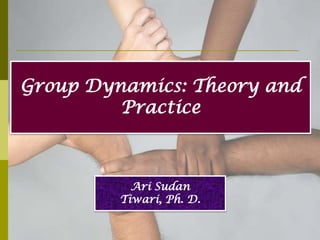
Group Dynamics: Theory and Practice
- 1. Group Dynamics: Theory and Practice Ari Sudan Tiwari, Ph. D.
- 2. Objectives To identify and analyze the processes that impact on group’s: Formation Development Performance Interaction among the group members To acquire the necessary skills to intervene and improve individual and group performance in an organizational context To build more successful organizations by applying techniques that provide positive impact on goal achievement
- 3. Groups: Concept Group means there are Two or more individuals Interacting and interdependent Perceive themselves as members of the group Come together to achieve particular shared objectives and goals
- 4. Groups: Formation and development Stages of group formation and development (Tuckman, 1965) Forming: Orientation, guidance (dependence) Storming: Conflict over roles and responsibilities, rules and procedures, individual recognition (counter-dependence) Norming: Issue resolution, Social agreements, cohesion, establishment of group norms (interdependence) Performing: Mutual assistance, creativity, understanding goals and roles (independence) Adjourning/Reforming/Transforming
- 5. Groups: Functions Task behaviours Maintenance behaviours Self-interest behaviours
- 6. Task behaviours Initiating Information seeking/giving Clarifying ideas Brining closure Consensus testing
- 7. Maintenance behaviours Encouraging Improving group atmosphere Harmonizing Compromising Gate-keeping
- 9. Group dynamics: Concept Structure of the group guiding interaction among group members The social process by which people interact in a group environment The influences of personality, power and behaviour on the group process
- 10. Group dynamics: Exchange theory Cost involved Reward received Outcome (reward-cost) Comparison level: Societal norms, past experiences, observations, alternate interactions (Reward-Cost)-CL
- 11. Factors of group dynamics: Types Structural factors Norms Roles Status Functional factors Cohesiveness Social loafing Conflict: Group and inter-personal
- 12. Group norms Social standards and acceptable behaviours (formal/informal) Collectively held expectations of group functioning Provide regularity and predictability to group functioning Norms differ among groups, communities and societies; but they all have them
- 13. Group norms: Types and classes Prescriptive Norms: Expectations within group regarding what is prescribed/supposed to be done Proscriptive Norms: Expectations within group regarding behaviors in which members are not prescribed/supposed to engage Classes of norms Performance norms Appearance norms Arrangement norms Allocation of resources norms
- 14. Roles Concept The set of behaviours and tasks that a group member is expected to perform because of his or her position in the group Types Assigned roles: Cross-functional/specific Emergent roles Issues in role play Role Identity: Attitude and behavior associated with a role Role Ambiguity: Unclear job definition Role Conflict: Job overlap
- 15. Status Socially defined position or rank given to the group members Differences in status characteristics create status hierarchies within group
- 16. Cohesiveness Degree to which members are: Attracted to one another Motivated to stay in the group Share group goals Have common values
- 17. Cohesiveness: Sources and consequences Sources Consequences Group size Level of participation Effectively managed diversity Group cohesiveness Level of conformity Group identity and healthy competition Emphasis on group goals Success
- 18. Enhancing cohesiveness Making small groups Encouraging agreement with the group goals Increasing the time members spend together Increasing the status of the group and the perceived difficulty of attaining membership in the group Stimulating competition with the other groups Reward to the group rather than to the individual members
- 19. Social loafing Concept The human tendency to put forth less effort in a group than individually Results in possibly lower group performance and failure to attain group goals Reducing social loafing Make individual efforts identifiable and accountable Emphasize the valuable contributions of individual members Keep group size at an appropriate level
- 20. Conflict: Group and inter-personal Concept Scarcity of resources and valued commodities Competition and struggle between people of groups over: Opposing needs and goals Ideas, values and attitudes
- 21. Conflict: Behaviour modes Competing Avoiding Compromising Accommodating Collaborating
- 22. Conflict: Sources Prejudices: Negative attitude towards a person only on the basis of his/her belongingness to a particular social group/section Discrimination: Expressed behaviours based on ones prejudices Social categorization: Us-vs.-Them Enhanced self-identity Socio-biological roots Realistic conflict and relative deprivation: Robbers’ cave study
- 23. Conflict: Resolution Increased proximity Social re-categorization Increased cooperation and super ordinate goal: Robbers’ cave study
- 24. Group dynamics: An optimum model Individual Level Group Level Organizational Level Cohesiveness Trust Shared Functions Adaptability Group effectiveness
- 25. Group dynamics: Practicing principles What is the group’s goal What are the patterns of communication in the group? What determines how influential each member is? What method of decision making is used and how effective is it? Why do/why don’t members challenge each other? What and how do conflicts arise and how are they managed? What actions by the group members help/hurt the group effectiveness?
- 26. Thank You
